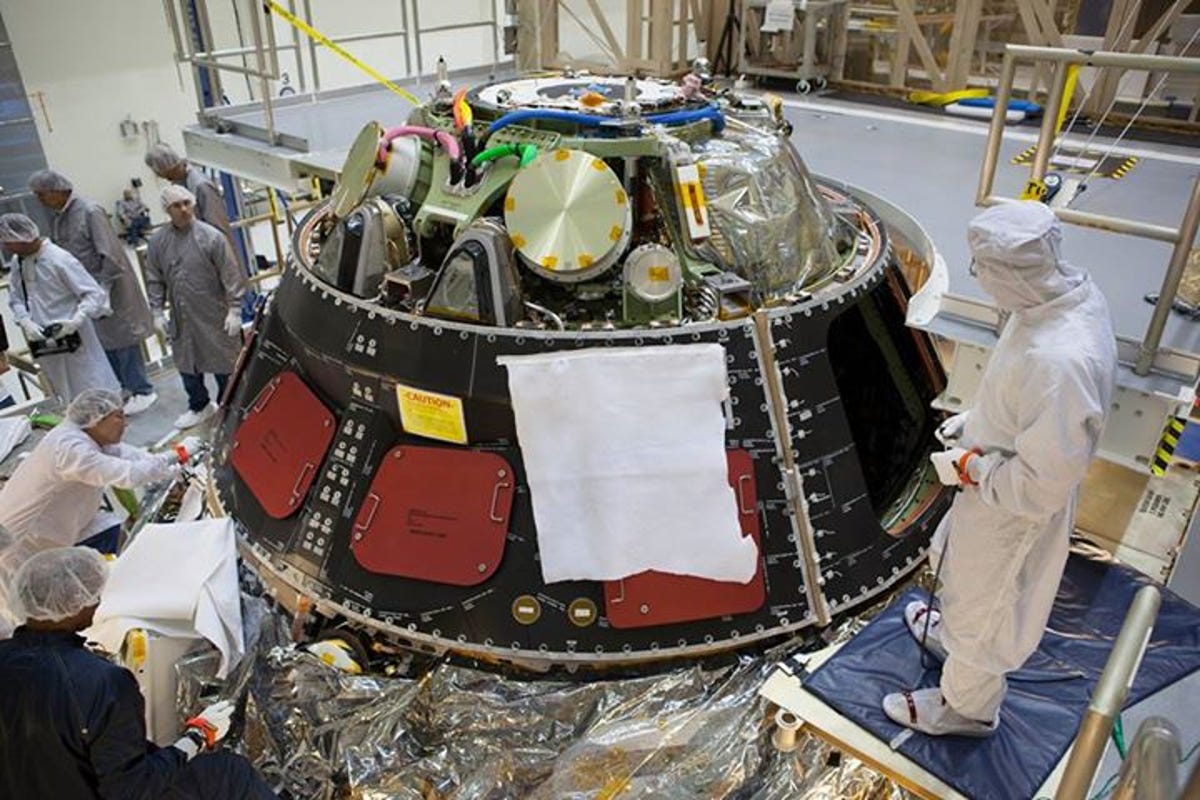Orion test flight takes humans closer to Mars (pictures)
NASA's next-gen Orion crew vessel is going on a test flight, and it's taking millions of names and some "Sesame Street" memorabilia with it.

First orbit, then Mars (eventually)
It's been awhile since humans have been outside of Earth's orbit, but NASA is planning to change that thanks to its next-generation manned spaceflight capsule, Orion.
While it looks superficially similar to an Apollo-era capsule, Orion is stocked with the latest space tech and designed for missions going deep into space, even all the way to Mars. A test flight scheduled for December 4 marks a tremendous step forward in Orion's development.
Related article: Orion space test flight a giant step toward humans on Mars
Welding Orion
Orion was still being built when this photo was taken in 2012. It shows the crew module's final weld before the capsule was sent along for installation of heat shielding and avionics systems. After years of development, Orion is now set for its first test flight, scheduled for December 4.
Related article: Orion space test flight a giant step toward humans on Mars
Microchip with a million names
To help get the general public excited about Orion, NASA launched a program that lets people sign up to have their names inscribed on a microchip that will fly along with the spacecraft on its first test flight, and then on future missions. The microchip holds more than a million names. Participants hope to one day have their names sent all the way to Mars.
Related article: Orion space test flight a giant step toward humans on Mars
"Sesame Street" in space
A microchip with more than a million names isn't the only unusual object to hitch a ride on Orion's first test flight. These technicians are holding a giant cookie that will also fly along. Some "Sesame Street" characters have supplied goodies to go into space. Cookie Monster's cookie, Ernie's rubber ducky, Slimey the Worm and Grover's cape will all soar into space when Orion takes off.
Related article: Orion space test flight a giant step toward humans on Mars
Orion crew will get new spacesuits
The advanced Orion crew module will work in conjunction with a new spacesuit when it eventually hosts humans onboard. The Advanced Crew Escape Suit (ACES) will integrate fully with Orion's life-support systems. Here, ACES undergoes testing in a device that suspends the wearer to mimic movement in a microgravity environment.
Related article: Orion space test flight a giant step toward humans on Mars
Orion prepares to splash down
This test version of the Orion spacecraft undergoes a water-impact test in 2012. It was dropped from 25 feet, creating the splash seen here. NASA has been preparing for a water recovery of the next-gen crew module. Orion's first test flight is scheduled for December 4. If all goes well, it will land in the Pacific Ocean and be recovered and returned to land.
Related article: Orion space test flight a giant step toward humans on Mars
Preparing to launch Orion
NASA's pre-launch activities are in full swing in anticipation of Orion's first test flight, scheduled for December 4. This photo was taken at Cape Canaveral Air Force Station's Launch Complex 37. It shows technicians preparing to mount the Orion spacecraft onto the rocket that will take it into space.
Related article: Orion space test flight a giant step toward humans on Mars
Orion and its rocket companion
If the weather cooperates, NASA will send the Orion spacecraft on its first test flight on December 4. Orion and the Delta IV Heavy rocket are shown together at the launch site in Florida. NASA will be watching closely to see how Orion's heat shield stands up to 4,000-degree temperatures. This test flight is a big step toward eventual manned flights using Orion to take humans deep into space.
Related article: Orion space test flight a giant step toward humans on Mars
Digital countdown clock for Orion
The Orion spacecraft isn't the only new technology getting a tryout when it goes for its first test flight. The old Apollo-era countdown clock that famously marked the start of many missions over decades of service has been retired in favor of this new digital display. The LED countdown clock will show video as well as the traditional numbers leading up to launch.
Related article: Orion space test flight a giant step toward humans on Mars
Artist's concept of Orion in space
Orion's first test flight, scheduled for December 4, will involve sending the next-gen spacecraft into orbit for a couple of runs around the planet before it returns with an anticipated splashdown in the Pacific Ocean. This artist's concept shows what Orion is expected to look like as it adjusts itself for reentry.
Related article: Orion space test flight a giant step toward humans on Mars

